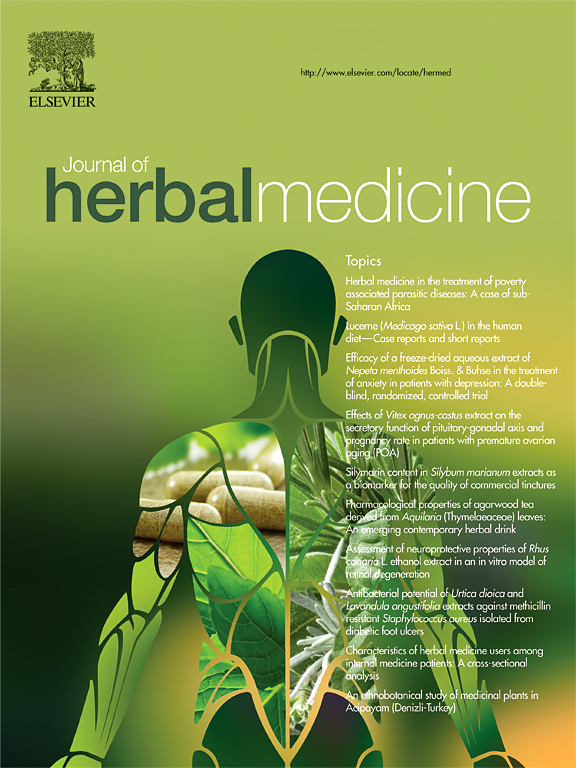In-vitro microbicidal activity of Ganoderma lucidum aqueous extract against selected pathogenic bacteria and yeast
IF 1.9
4区 医学
Q2 INTEGRATIVE & COMPLEMENTARY MEDICINE
引用次数: 0
Abstract
Introduction
The potential antibacterial properties of aqueous extracts of Ganoderma lucidum, particularly its ability to combat pathogenic bacteria and fungi, have captivated the interest of both the scholarly and pharmaceutical sectors. This investigation was conducted to explore the antimicrobial efficacy of aqueous extracts of G. lucidum: Sample A (subjected to boiling for 1 hour) and Sample B (subjected to boiling for 3 hours) against pathogenic bacteria and yeast.
Method
Standard microbiological procedures were used to isolate, identify, and determine the antimicrobial properties of the extracts. A standard procedure was utilised to prepare the samples.
Results
As evidenced in the study, a notable disparity was observed in the impact of the Sample A extract on the test isolates, with the most pronounced effect noted on Staphylococcus spp at a concentration of 1 000 mg/ml (10.33 ± 0.88 mm). Conversely, no antimicrobial activity (0.00 ± 0.00 mm) was detected in any concentration against E. coli, Enterobacter spp, Bacillus spp, and Candida spp. Moreover, the findings pertaining to Sample B indicated that the most substantial effect was observed on Pseudomonas spp at 1 000 mg/ml (6.67 ± 0.33 mm). Conversely, no antimicrobial efficacy (0.00 ± 0.00 mm) was observed in all concentrations of the extract against Staphylococcus spp and Candida spp, while E. coli, Enterobacter spp, and Bacillus spp exhibited no activity at concentrations of 125 and 62.5 mg/ml.
Conclusion
These findings demonstrate the presence of bioactive substances with a wide range of antibacterial action in G. lucidum confirming assertions of the traditional herbalists that some bacterial diseases in people may be treated with Ganoderma species, hence the need for further study on compound isolation guided bio-assay.
灵芝水提物对病原菌和酵母菌的体外杀菌活性研究
灵芝水提取物的潜在抗菌特性,特别是其对抗致病菌和真菌的能力,已经引起了学术界和制药部门的兴趣。本实验研究了灵光子水提物A(煮沸1 小时)和B(煮沸3 小时)对病原菌和酵母菌的抑菌效果。方法采用标准微生物学方法分离、鉴定和测定提取物的抗菌性能。采用标准程序制备样品。结果a样品提取物对不同分离株的影响存在显著差异,对葡萄球菌的影响在浓度为1 000 mg/ml(10.33±0.88 mm)时最为显著。相反,在任何浓度下,对大肠杆菌、肠杆菌、芽孢杆菌和念珠菌均无抑菌活性(0.00±0.00 mm),而且样品B的结果表明,当浓度为1 000 mg/ml(6.67±0.33 mm)时,对假单胞菌的抑菌效果最显著。相反,所有浓度的提取物对葡萄球菌和念珠菌均无抑菌效果(0.00±0.00 mm),而大肠杆菌、肠杆菌和芽孢杆菌在浓度为125和62.5 mg/ml时均无抑菌效果。结论灵芝中含有多种具有广泛抗菌作用的活性物质,证实了传统中医关于灵芝可用于治疗某些细菌性疾病的论断,需要进一步开展复方分离引导生物测定的研究。
本文章由计算机程序翻译,如有差异,请以英文原文为准。
求助全文
约1分钟内获得全文
求助全文
来源期刊

Journal of Herbal Medicine
INTEGRATIVE & COMPLEMENTARY MEDICINE-
CiteScore
3.90
自引率
0.00%
发文量
94
期刊介绍:
The Journal of Herbal Medicine, the official journal of the National Institute of Medical Herbalists, is a peer reviewed journal which aims to serve its readers as an authoritative resource on the profession and practice of herbal medicine. The content areas of the journal reflect the interests of Medical Herbalists and other health professionals interested in the clinical and professional application of botanical medicines. The objective is to strengthen the research and educational base of herbal medicine with research papers in the form of case studies, original research articles and reviews, monographs, clinical trials and relevant in vitro studies. It also publishes policy statements, opinion pieces, book reviews, conference proceedings and profession related information such as pharmacovigilance reports providing an information source for not only the Herbal Practitioner but any Health professional with an interest in phytotherapy.
 求助内容:
求助内容: 应助结果提醒方式:
应助结果提醒方式:


